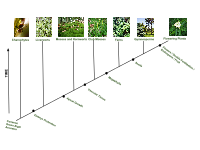
Photo from wikipedia
BackgroundThe available data demonstrate that even in universal metabolic pathways, some species-specific regulatory features of structural genes are present. For instance, in the anthocyanin biosynthesis pathway (ABP), genes may be… Click to show full abstract
BackgroundThe available data demonstrate that even in universal metabolic pathways, some species-specific regulatory features of structural genes are present. For instance, in the anthocyanin biosynthesis pathway (ABP), genes may be regulated by ABP-specific regulatory factors, and their expression levels may be strongly associated with anthocyanin pigmentation, or they may be expressed independently of pigmentation. A dataset of orthologous ABP genes (Chs, Chi, F3h, F3’h, Dfr, Ans) from monocot and dicot plant species that have distinct gene regulation patterns and different types of pollination was constructed to test whether these factors affect the evolution of the genes.ResultsUsing a maximum likelihood approach, we demonstrated that although the whole set of the ABP genes is under purifying selection, with greater selection acting on the upstream genes than on the downstream genes, genes from distinct groups of plant species experienced different strengths of selective pressure. The selective pressure on the genes was higher in dicots than in monocots (F3h and further downstream genes) and in pollinator-dependent plants than in pollinator-independent species (Chi and further downstream genes), suggesting an important role of pollination type in the evolution of the anthocyanin biosynthesis gene network. Contrasting effects of the regulation patterns on evolution were detected for the F3h and Dfr genes, with greater selective pressure on the F3h gene in plant species where the gene expression was not strongly associated with pigmentation and greater selective pressure on Dfr in plant species where the gene expression was associated with pigmentation.ConclusionsWe demonstrated the effects of pollination type and patterns of regulation on the evolution of the ABP genes, but the evolution of some of the genes could not be explained in the framework of these factors, such as the weaker selective pressure acting on Chs in species that attract pollinators or the stronger selective pressure on F3h in plant species where the gene expression was not associated with pigmentation. The observations suggest that additional factors could affect the evolution of these genes. One such factor could be an effect of gene duplication with further division of functions among gene copies and relaxed selective pressure acting on them. Additional tests with an appropriate dataset combining data on duplicated gene sequences and their functions in the flavonoid biosynthesis pathway are required to test this hypothesis.
Journal Title: BMC Plant Biology
Year Published: 2017
Link to full text (if available)
Share on Social Media: Sign Up to like & get
recommendations!